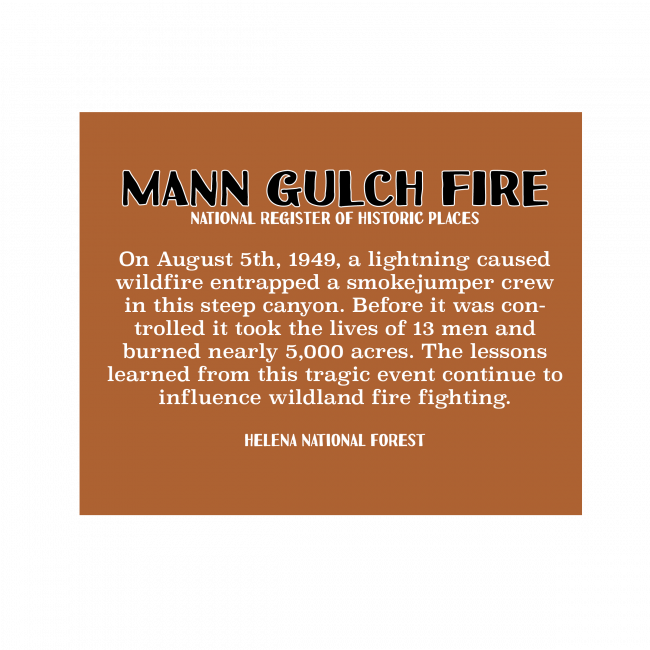
AUGUST 5 IS THE ANNIVERSARY of the Mann Gulch Fire in 1949 near Helena, Montana. On that fateful day, temperatures were in the high 90s. From the fuselage side-door of a Douglas DC-3/C-47 aircraft, 15 smokejumpers fell from the sky and landed in the wilds of the Gates of the Mountains Wilderness. Their day was over in less than two hours — their boots hit the ground just after 4 p.m. and they perished before 6 p.m. It has been estimated that 3,000 acres burned in 10 minutes during its “blow-up” stage, with the fire eventually burning 4,500 acres across five days. The fire had started with a bolt of lightning.
Once on the ground, the smokejumpers rendezvoused with a forest ranger/fire guard. Of that 16-man crew, 13 met their fiery deaths — 12 of the smokejumpers and that ranger. Three survived: Wagner Dodge of Missoula, Montana; the smokejumper foreman, age 33 at the time of the fire, who died from Hodgkin’s Lymphoma in 1955; Walter Rumsey from Lamed, Kansas, 21 years old at the time of the fire, who died in an airplane crash in 1980; and Robert Sallee from Willow Creek Montana, 17 years old at the time of the fire, who died in 2014.
Honor the Fallen: Robert Bennett, 22, Paris, Tennessee; Eldon Diettert, 19, Moscow, Idaho (died on his birthday); James Harrison (the ranger), 20, Missoula, Montana; William Hellman, 24, Kalispell, Montana; Philip McVey, 22, Babb, Montana; David Navon, 28, Modesto, California; Leonard Piper, 23, Blairsville, Pennsylvania; Stanley Reba, 25, Brooklyn, New York; Marvin Sherman, 21, Missoula, Montana; Joseph Sylvia, 24, Plymouth, Massachusetts; Henry Thol, 19, Kalispell, Montana; Newton Thompson, 21, Alhambra, California; Silas Thompson, 21, Charlotte, North Carolina.
Honor the Fallen: the location of the Mann Gulch Fire was added as a historical district to the U.S. National Register of Historic Places in May 1999. A sign is placed near Mann Gulch to memorialize the tragedy. The sign can be seen from the waters of the nearby Missouri River — those Cold Missouri Waters.
Cold Missouri Waters is the title of a song penned by James Keelaghan and covered by many artists: “Thirteen crosses high above the cold Missouri waters, August ’49 North Montana, the hottest day on record the forest tinder dry, lightning strikes in the mountains, I was crew chief at the jump base, I prepared the boys to fly … Fifteen of us dropped above the cold Missouri waters … Flames one step behind above the cold Missouri waters, Sky had turned red, smoke was boiling … Thirteen stations of the cross to mark their fall … I’ve had my say I’ll confess to nothing more, I’ll join them now those that they left me long before. Thirteen crosses high above the cold Missouri waters.”
Honor the Fallen: the Mann Gulch Fire has also been memorialized by book and by movie. Perhaps the definitive book about this event is Young Men and Fire, written by Norman Maclean (1902-90) with a posthumous publication date of 1992 (University of Chicago Press). Maclean had worked in logging camps in northwestern Montana and for the U.S. Forest Service in his younger years. He also became a professor of English at the University of Chicago. The book won the National Book Critics Circle Award for nonfiction and recounts the events of the tragedy through an investigative eye.
Red Skies of Montana is a movie from 1952 starring Richard Widmark and is loosely based on the Mann Gulch Fire with Widmark as a smokejumper trying to save his crew. In reality, that movie was based on a 1948 novel by George Stewart entitled Fire. As well, in 1956, a one-hour television adaptation entitled Smoke Jumpers was broadcast. I’ve read Maclean’s book (the 25th anniversary edition), and I’ve watched the movie. I listen to the song Cold Missouri Waters (on the 2012 CD by Smythe & Taylor — local Westcliffe singer/songwriters). Honor the Fallen.
Let us not forget other notable U.S. wildland fires resulting in firefighter fatalities. The Griffith Park Fire (47 acres) was a brush fire in Los Angeles, California, in 1933. It killed 29 civilians trying to beat back the flames using only shovels. The Blackwater Creek Fire (1,700 acres) near Cody, Wyoming, in 1937 was caused by lightning and killed 15 firefighters. Arson started the Rattlesnake Fire (1,300 acres) in northern California in 1953. It killed 15 firefighters. The Thirtymile Fire (9,300 acres) near Winthrop, Washington, in 2001 was caused by an unattended campfire and killed four firefighters.
Arson killed five more firefighters in the Esperanza Fire (41,200 acres) near Palm Springs, California, in 2006. The Yarnell Hill Fire (1,300 acres) near Yarnell, Arizona, in 2013 was caused by lightning and killed 19 firefighters. The 2018 movie Only the Brave is a decent rendition of the Granite Mountain Hotshots fire team — only one survived. That sole survivor, Brendan McDonough, published his story My Lost Brothers in 2016. Honor the Fallen.
Colorado has had its share of wildland fires resulting in firefighter fatalities. The South Canyon Fire (2,115 acres) near Glenwood Springs in 1994 was caused by lightning and killed 14 firefighters. It was the subject of John Maclean’s book Fire on the Mountain: the True Story of the South Canyon Fire. (John Maclean is the son of Norman Maclean and has written books on the Rattlesnake, Thirtymile, Esperanza and other fires). Arson started the Hayman Fire (138,114 acres) between Colorado Springs and Denver in 2002. Five firefighters died in a vehicular accident as they traveled to battle that blaze).
Even without firefighter fatalities, fires in Colorado comprise a significant block of data in U.S. wildland fire accounts, and 2020 was an especially mind-boggling year. Colorado’s top 10 fires in 2020 accounted for more than 841,000 acres burned. Cameron Peak, East Troublesome, Mullen (includes Wyoming acreage), Pine Gulch, Grizzly Creek, Mt. Zirkel, Middle Fork, Williams Fork, Cherry Canyon, Calwood, and the list goes on. Colorado no longer has a fire “season” — it’s all year long — it’s now fire years. Seemingly that same statement can be applied to the U.S. as a whole.
Other notable monstrous fires (greater than 50,000 acres) for Colorado include: the 2002 Missionary Ridge Fire, which burned 72,000 acres; the 2012 High Park Fire, 87,000 acres; the 2013 West Fork complex, 110,000 acres; the 2018 416 and Burro Fire Complex, 54,000 acres; and the 2018 Spring Creek Fire at 108,000 acres. I remember watching the “fire tornadoes” of the Spring Creek Fire from my location in Custer County. I arbitrarily chose the 50,000-acre threshold for what I declared to be monstrous fires. For the mathematically inclined, 50,000 acres equals 78 square miles (64 acres equals 1 square mile). Tallying burned acres is not an exact science and some of these numbers are approximations or rounded.
Lightning is a predominant natural cause of wildland fire; but since nature is uncontrollable, let’s focus on human-caused fire. According to research by the National Park Service and the U.S. Forest Service, nearly 85% of wildland fires are caused by people: unattended campfires, debris burning, equipment use or malfunction, arson and negligently discarding cigarette butts (or other smoking materials). The careless attitude of smokers claims the lives of hundreds of thousands of animals and trees as well as people. Colorado Revised Statutes 18-4-511, 33-15-108, and 42-4-1406 all prohibit littering, and all have sections therein that emphasize tossing cigarette butts or other burning material. Don’t be a butthead.
Honor the Fallen. Please take a moment and visit the Wildland Firefighter Foundation’s website: WFFoundation.org/the-fallen. As well, honor the living — those wildland firefighters and thousands of other first responders. Perhaps if we honor those emergency responders more and better, we can have fewer of the Fallen to honor.
Bill Christie lives in Custer County that enacted its first fire ban stage for the year back in April.

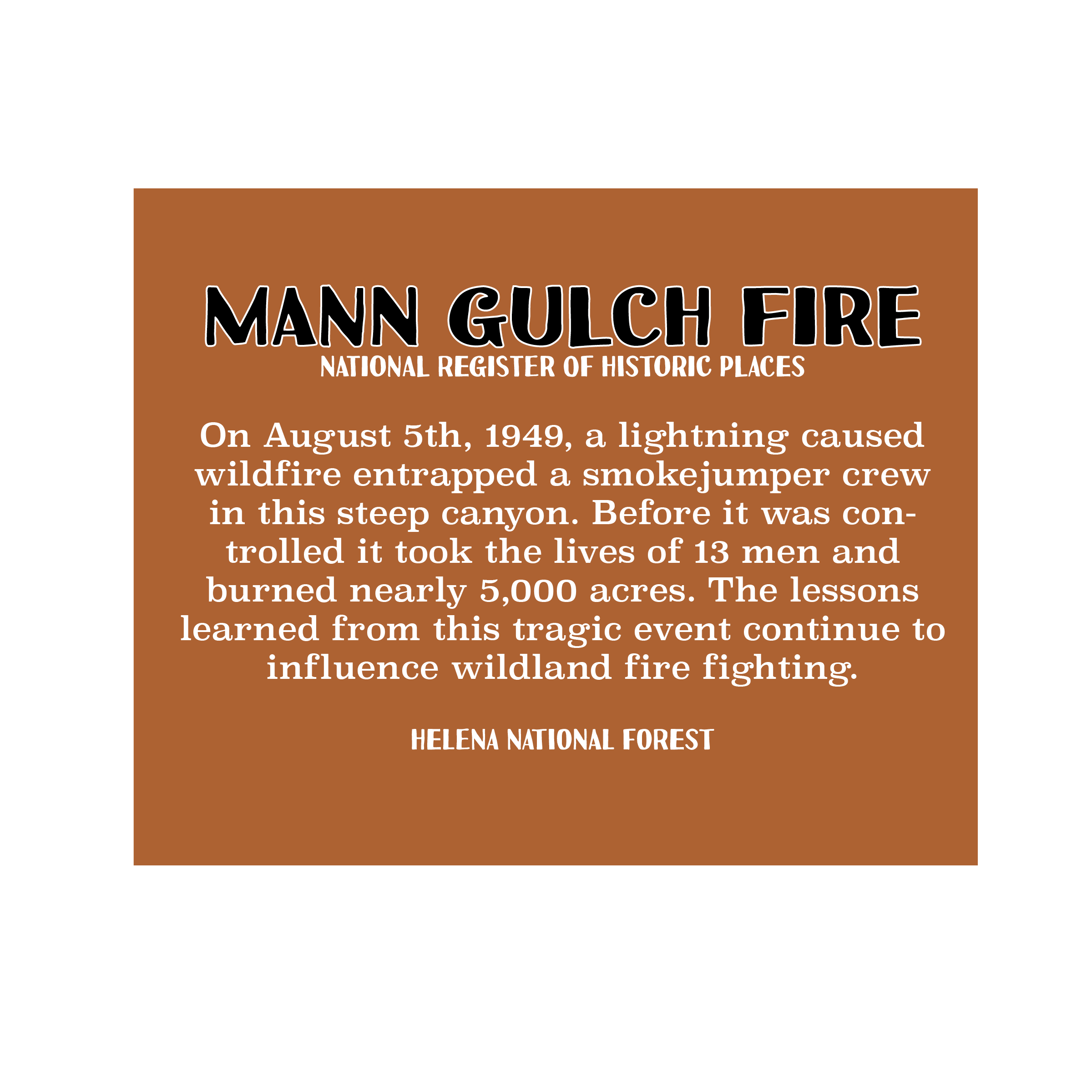
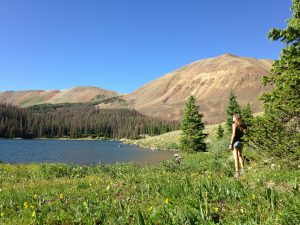
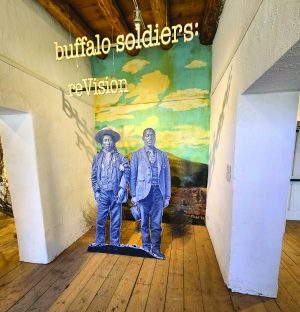
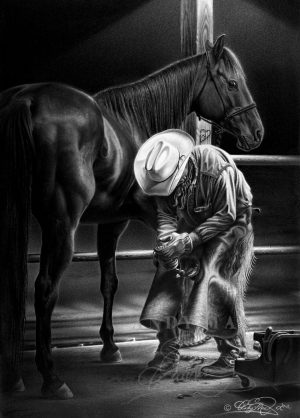
Thanks for your attention to this often under appreciated profession and the human factor at play in so many devastating fires (not to mention the urban/wildland interface where humans choose to build too close to/inside forests forcing a human response. And part 2, the let it burn philosophy?
I have PTS partially from the horrific Sonoma County CA fire of 2017